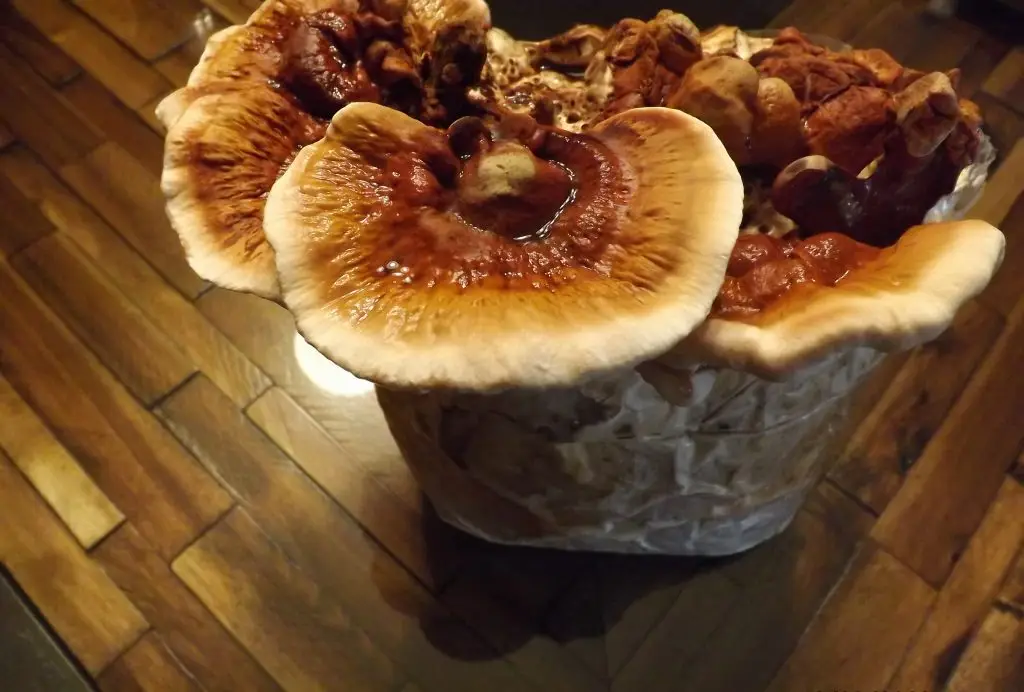The Ultimate Guide to Growing Reishi (Ganoderma lingzhi) Mushrooms
Growing Reishi (Ganoderma lingzhi) mushrooms—also known as Lingzhi or the “Mushroom of Immortality”—have been revered in traditional Chinese medicine for over 2,000 years. Known for their glossy red caps and medicinal properties, Reishi mushrooms are believed to support immune function, reduce stress, and promote overall wellness.
In this in-depth guide, we’ll explore growing Reishi (Ganoderma lingzhi) mushrooms at home or commercially. Whether you’re a beginner or an experienced cultivator, this guide will cover everything from choosing the right substrate to harvesting and drying your Reishi mushrooms for medicinal use.

What Are Reishi (Ganoderma lingzhi) Mushrooms?
Ganoderma lingzhi, commonly called Reishi, is a type of woody, polypore mushroom native to Asia. Unlike many edible mushrooms, Reishi mushrooms have a tough, cork-like texture and are typically consumed as a tea, tincture, or powder rather than eaten whole.
Key Benefits of Reishi Mushrooms:
- Immune system support
- Anti-inflammatory and antioxidant properties
- Stress and anxiety reduction
- Liver and cardiovascular health benefits
Due to their medicinal reputation, Reishi mushrooms are in high demand in the wellness industry.
Growing Reishi (Ganoderma lingzhi) Mushrooms
Growing Reishi mushrooms requires patience and attention to environmental conditions. There are two primary methods:
- Bag cultivation on sawdust blocks
- Log cultivation (outdoor, long-term method)
Let’s explore both methods.
Method 1: Growing Reishi Mushrooms on Sawdust Blocks
This is the most popular method for indoor and commercial growers, offering faster fruiting cycles and easier environmental control.
Step 1: Choosing the Right Substrate
Reishi mushrooms grow best on hardwood sawdust-based substrates. Supplementing the substrate helps increase yield.
📌 Best substrate mix for Ganoderma lingzhi:
- 80% hardwood sawdust (oak or maple)
- 20% wheat bran or rice bran
- Optional: 2% gypsum (calcium sulfate) to buffer pH
- Water content: 60–65% moisture (should feel like a damp sponge)
Step 2: Sterilization
Sterilizing your substrate is critical to prevent contamination.
🔥 Sterilization options:
- Pressure cooker: Sterilize at 15 PSI for 90 minutes
- Autoclave: For larger operations
Once sterilized, allow the substrate to cool completely before inoculating.
Step 3: Inoculation with Reishi Mushroom Spawn
Use grain spawn of Ganoderma lingzhi for best results. Mix the spawn into the cooled substrate inside a clean environment or laminar flow hood.
📦 Place the inoculated substrate into filter patch grow bags or polypropylene containers.
Where to buy Reishi mushroom spawn for Growing Reishi (Ganoderma lingzhi) Mushrooms.
Step 4: Incubation
🕒 Incubation Time: 2–3 months
📍 Ideal Conditions:
- Temperature: 75–80°F (24–27°C)
- Humidity: 65–75%
- No light needed during colonization
- CO₂ buildup is okay at this stage
You’ll know the block is ready when it’s fully colonized by white mycelium and begins to form antler-like primordia or “fingers.”
Step 5: Fruiting Conditions
To induce fruiting and encourage the formation of conk-style Reishi mushrooms, adjust the environmental parameters.
🌱 Fruiting Setup:
- Temperature: 70–75°F (21–24°C)
- Humidity: 85–95%
- Light: 12 hours of indirect light per day
- Fresh air exchange: Lower CO₂ to encourage cap development
Depending on CO₂ levels and humidity, Reishi will form either antler-shaped mushrooms (in high CO₂) or fan-shaped conks (in fresh air).
🧪 Many cultivators intentionally grow Reishi in high CO₂ environments to harvest slender antlers for ease of drying and extraction.
Step 6: Harvesting Reishi Mushrooms
Ganoderma lingzhi mushrooms are typically harvested 60–90 days after fruiting begins, depending on the morphology.
🧾 How to know when Reishi is ready to harvest:
- Conks or antlers are fully colored (reddish-brown or deep orange)
- No longer growing rapidly
- Cap edges begin to flatten or harden
🔪 Use a sharp knife or scissors to cut mushrooms at the base.
Step 7: Drying and Storage
Because Reishi mushrooms are not eaten fresh, drying is essential.
🔥 Drying Methods:
- Use a dehydrator at 110–120°F (43–49°C) until completely dry
- Air-dry in a warm, well-ventilated space for several days
💼 Store dried Reishi in airtight containers in a cool, dark place. Properly dried Reishi can last up to 1 year.
Method 2: Growing Reishi (Ganoderma lingzhi) Mushrooms on Logs
This method mimics natural growth conditions and provides long-term yields over multiple years.
Step 1: Selecting Logs
🪵 Ideal log types:
- Oak
- Beech
- Maple
- Elm
Logs should be 3–6 inches in diameter and cut during dormancy (late fall to early spring). Let logs rest for 2–3 weeks before inoculation.
Step 2: Inoculation
Use plug spawn or sawdust spawn of Ganoderma lingzhi.
📌 Inoculation process:
- Drill holes (5/16” diameter) in a diamond pattern
- Insert spawn using a mallet or plunger
- Seal holes with cheese wax or beeswax
Step 3: Incubation and Fruiting
🕒 Logs require 8–14 months to incubate in a shaded, moist area.
📍 Ideal conditions:
- Shade or 80% shade cloth
- Regular watering or rainfall to keep logs moist
Reishi mushrooms fruit naturally during warm, humid months. Fruiting may occur once or twice a year, and logs can continue producing for up to 5 years.
Common Problems and Solutions When Growing Reishi (Ganoderma lingzhi) Mushrooms
1. Contamination (especially in sawdust bags)
✔ Ensure complete sterilization
✔ Work in clean, sterile environments
2. Poor fruiting or abnormal shapes
✔ Adjust humidity and fresh air
✔ For flat conks, increase oxygen exchange
3. Mycelium not colonizing
✔ Check moisture content of substrate
✔ Ensure temperature is within range
Using Reishi (Ganoderma lingzhi) Mushrooms
Reishi is used primarily for medicinal purposes, not culinary. Once dried, mushrooms can be:
🍵 Brewed into tea
💊 Ground into powder for capsules
💧 Extracted into dual tinctures (alcohol + hot water)
For more on Reishi health benefits and preparation methods, visit:
Where to Buy Ganoderma lingzhi Supplies
- Spawn & Cultures: The Spore Depot
- Grow Bags & Substrates: Mushroom Media Online
- Books & Resources:
- Growing Gourmet and Medicinal Mushrooms by Paul Stamets
- Mycelium Running by Paul Stamets
Final Thoughts on Growing Reishi (Ganoderma lingzhi) Mushrooms
Cultivating Reishi mushrooms is a deeply rewarding practice—both for health and for connecting with one of nature’s most respected medicinal fungi. Whether you grow them on sawdust blocks for quicker harvests or on logs for long-term sustainability, Ganoderma lingzhi mushrooms offer powerful benefits and are increasingly in demand in holistic health markets.
With the right tools, clean techniques, and patience, you can grow your own Reishi mushroom supply for teas, tinctures, and wellness products year-round.
#GanodermaLingzhi #ReishiMushrooms #MushroomFarming #GrowMedicinalMushrooms #FungiCultivation #ReishiBenefits





